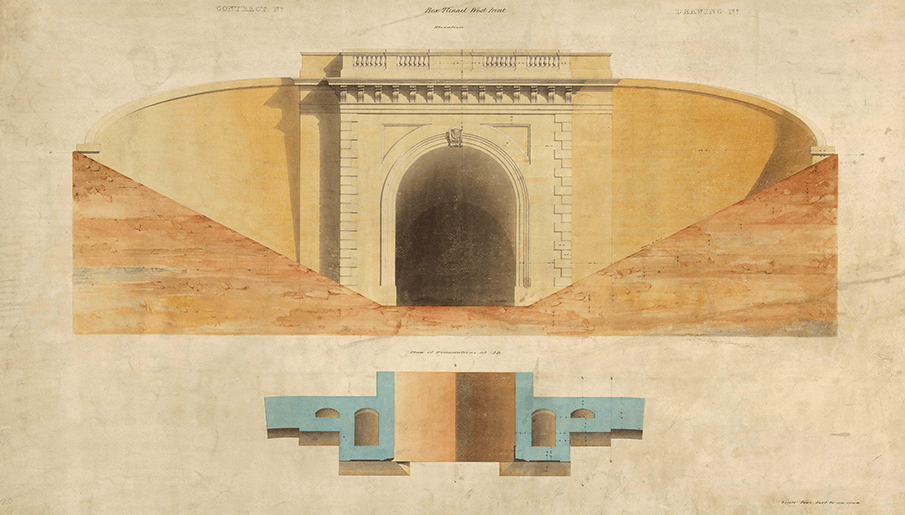在开业时,布鲁内尔的盒子隧道是有史以来最长的铁路隧道。
Controversial from the start, its problematic construction delayed the completion of the Great Western Railway’s London to Bristol route until June 1841. Today it is one of Isambard Kingdom Brunel’s most celebrated structures.

1835: 31 August, the Great Western Railway was authorised by an Act of Parliament to build the railway line between the cities of London and Bristol.
1838: George Burge of Herne Bay, Thomas Lewis of Bath and William Brewer of Box are contracted to build the tunnel.
1836: work on Box Tunnel begins.
1841:4月,箱隧道完成。
1841: 30 June, Box Tunnel opened and through services between London and Bristol commence.
1861:来自伦敦到布里斯托尔的行被转换为混合仪表轨道。
1892:5月20日,最后一个GWR宽仪轨道被提升。
1986: restoration of the tunnel was undertaken. A viewing platform on London Road (A4, Bath) was opened to give visitors the best view of the western portal.
2009: the electrification of London (Paddington) – Bristol – Swansea announced by Network Rail.
2010: March, Network Rail clears overgrown plants and foliage growing along the embankment around the tunnel’s west portal to improve the vista from the viewing platform on London Road.
An impossible project
最初提出在1835年的伟大西部铁路法案,通过Box Hill构建隧道是一个不可能和危险的工程项目,根据其批评者。箱隧道位于Chippenham和Bath之间,是迄今为止整个伦敦最困难的单一工程工作,因为它包含了Brunel的标准,在100个中占据了异常陡峭的梯度,在100个中的长度。
Bath Stone
Between 1836 and 1837 eight shafts were sunk at intervals through the hill and along the projected alignment to establish the nature of the underlying rock. Over the course of nearly two miles the tunnel dipped westbound through several overlying geological strata comprising of Great Oolite limestone (Bath Stone), and Inferior Oolite, Fuller’s Earth (which is particularly prominent in the Bath district) and a small amount of Lias Clay at the western end. At 9636ft (2,937m) with a 25ft (7.6m) diameter bore, contemporary reports put the total volume of material extracted from the tunnel at 247,000 cubic yards (189,000 cubic metres).
Two contractors were appointed to construct the tunnel; George Burge from Herne Bay was the major contractor, responsible for 75 per cent of the overall length of the tunnel working from the west, and Messers Lewis and Brewer, who were locally sourced contractors responsible for the remainder. Construction of the tunnel began in December 1838.
Railway navvies
建造隧道时的工作条件并不好。将隧道的结构分为六个隔离部分,并且对于这些距离的大部分时间仅通过通风轴进行,直径25英尺(7.6米),深度为70至300英尺(21.3至91.5M)。。爆破,每周消耗1吨爆炸物,在这些腔室和工人存在的情况下进行。唯一的照明是通过蜡烛,其中每周也消耗了1吨的重量。在隧道的早期建设期间,工人往往不得不尽可能快地撤离,因为水从巨大的鲕粒层涌出。必须增加抽水设施以处理相当大的流入。
The final piece
overdue of ob隧道延迟从伦敦到布里斯托尔的整个线路的开放,到1839年8月,只有40%的隧道建造。到了1840年夏天,帕丁顿到法灵顿路(斯曼登以东)和浴室到布里斯托尔部分的线条已经完成。因此,1月1841年,布鲁内尔·蔡··贾尔德他的主要承包商将劳动力从十二百到四千名男子增加,并通过他们的超人努力,隧道于1841年4月有效地完成。隧道的工作已经从东部开始工作了1836年Box Hill的西侧;布鲁内尔的计算和承包商和登记的技能使得当两端在1841年举行会议时,它们的对准差异小于2英寸(5cm)。布鲁尔为隧道的西端设计了一个古老的古典门户,但东门户较少,简单的石材。它于1841年6月30日通过伦敦(Bristol交通)开放,没有仪式。
Did you know?
传说升起的太阳照耀在Box Tunnel on Brunel’s birthday, 9 April. Recent research has shown that unfortunately this is not the case, although the sun does shine directly through the tunnel on several other days throughout April and again in September.
